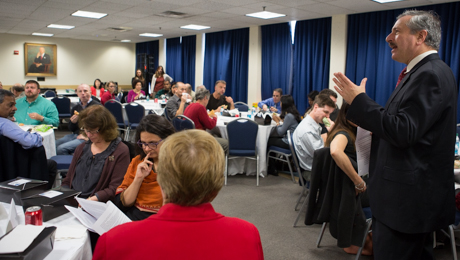Dozens of George Washington University faculty members and researchers met last week to examine the teaching of science, engineering and related subjects, and the university’s potential as a leader in science education research.
The emphasis on the teaching of science, technology, engineering and math—collectively known by the acronym STEM—is part of an overarching focus in the university’s new 10-year strategic plan, which includes the proposed creation of a STEM Academy.
“Like many actions in the strategic plan, [the academy] is aspirational,” Provost Steven Lerman said, addressing the group at the start of Friday’s meeting.
“It’s an important area,” Dr. Lerman said. “The good news is it’s an area of great national attention. … There are clearly aspirations among government, industry and not-for-profits around improving the quality of STEM education.”
The meeting, convened by the provost’s Office of Teaching and Learning, brought together around 50 GW faculty members, from professors of chemistry and electrical engineering to those of pedagogy and special education. The participants held small-group discussions on how to elevate GW’s capacity and reputation for teaching STEM subjects and conducting STEM education research, and how to leverage GW’s strengths in the competition for top STEM students.
The university has “lots of pockets of good research and thinking” regarding STEM education, said Geralyn Schulz, associate dean for research at the Columbian College of Arts and Sciences and one of the faculty members who helped organize the meeting. “One of the best things was just to get in the room everyone who is thinking about it, and to get those little pockets coalesced perhaps into bigger groups that have core interests in common.”
Comments from the discussion groups and individuals were collected and will be read for common themes, which may serve as fodder for future STEM events, Dr. Schulz said.


